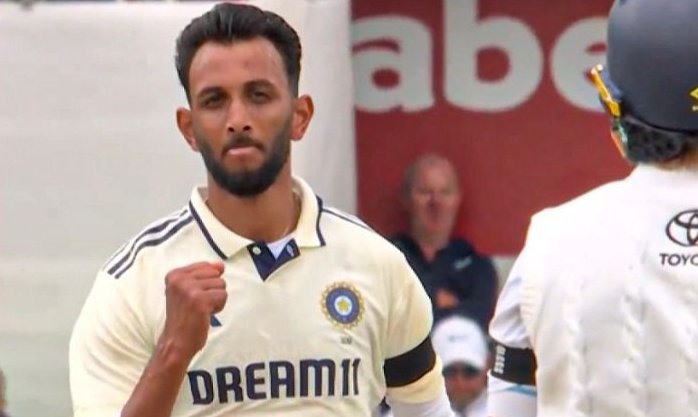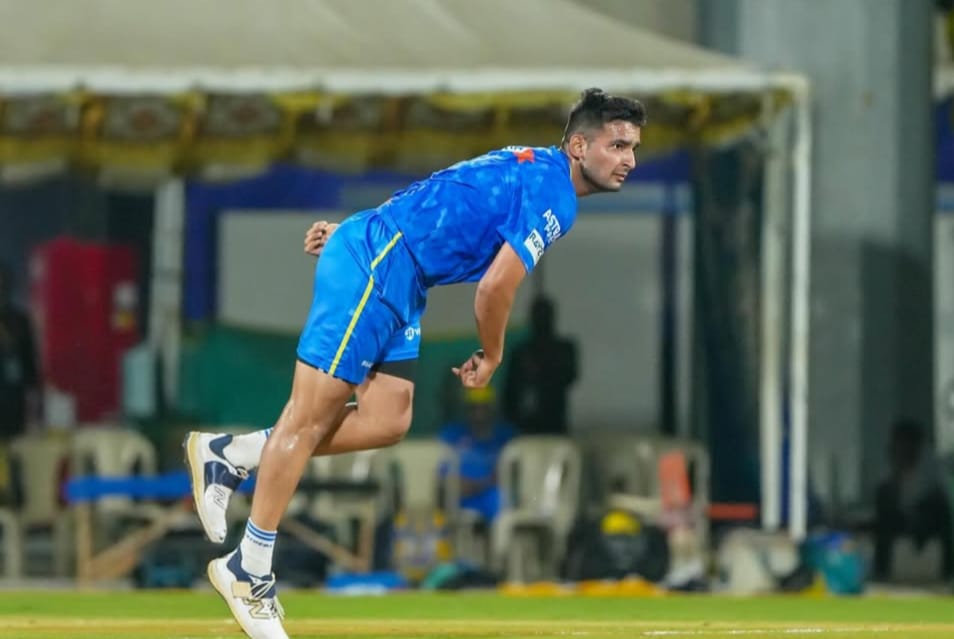
Over the last decade, there is one aspect of the game that has changed a bit in England – The advent of wobble seam and how it seems to have gradually replaced swing bowling. It doesn’t mean that the pace bowlers have forgotten the art of keeping the seam upright, but the wobble seam seems to have gained precedence over swing bowling in England.
Eric Simons, the current CSK bowling coach, has a slightly different take on it. The articulate former South African all-rounder said this to RevSportz: “We are seam bowlers, we are swing bowlers, the seam is there for us to hit,” he noted. “What bothers me sometimes or rather what one has to be careful about is bowling wobble seam. You need to look after your seam; that you can bowl swing with a very good seam position. I think with T20 cricket, good swing bowlers may swing the ball for 6,7, 8, 9, 10 or 12 balls or into the third over if you’re lucky.
“And then the seam is breaking your wrist, bowling slower balls, bowling something different. I think what happens is if you are not careful, you lose your strong swing position. So, wobble seam has become a very, very powerful weapon, but it is important that coaches and bowlers make sure that they can still bowl seam-up because that is the foundation on which you bowl. If you only bowl wobble seam, then you become restricted. Yes, it has become effective, but I would still encourage bowlers to bowl seam-up. I saw a lot of wobble seam (in the WTC final), I pretty much didn’t see any seam-up. Sometimes, it bothers me that they bowl wobble seam because they can’t bowl seam-up,” he observed.
Soon, the discussion shifted towards the recently concluded WTC final at Lord’s. South Africa went on to break a 27-year jinx in terms of not winning an ICC tournament by hoisting the WTC trophy. So, how does Simons look at South Africa’s glittering achievement? Over the last three decades, Simons himself has been involved with the South African set-up in various capacities – first as a player and then taking over coaching duties.
“It is a wonderful achievement for the guys, they have done extremely well,” he said. “We go back to when CSA and the players were targeting the final of the World Test Championship, I don’t think too many people believed that they could achieve it. So, along the way they have had some incredible victories. The games they had to win were remarkable. To get there (the final at Lord’s) as underdogs, then to bowl Australia out cheaply, then to get themselves bowled out very cheaply. I guess a lot of people thought that they were doomed.
“But the fight back they did was tremendous. As we got closer, everyone in the country was getting more and more interested, more and more excited. So, as an ex-player, as a coach, and just as a South African, it is wonderful to finally get that jinx off your back. Hopefully, it is the first of many,” he added.

That thrilling final won’t just be remembered for how the pace bowlers from both sides employed wobble seam, but also for the exploits of Kagiso Rabada. The South Africa pace spearhead ended up with nine wickets in the match. So, what does Simons make about the greatness of Rabada? What are the salient features of his pace bowling?
Simons shared his thoughts on a bowler who has an astounding strike rate of 38.9 in Test cricket. “I don’t think people appreciate how good he is. I don’t think people realise what he has exactly achieved,” he observed. “He isn’t one of those guys who bowls at the speeds that other guys have done or bowls a lot of bouncers. But he is relentless and he is a naturally talented cricketer. His action isn’t quite conventional which I think has assisted him. When he gets his bit between his teeth, he is a star performer.
“From South Africa’s perspective, he was the key to setting up the batting team to win it. I think one of his strengths is that his action is a little bit unconventional. He bowls a little bit of the wrong foot, it is not quite but it is just a bit different. I think the batsmen don’t get settled against him, and he doesn’t bowl a lot of bad balls. He doesn’t really have a fantastic seam position, but he is just consistent. Hitting on the seam, hitting around the seam, always doing something. The ball definitely hits the bat faster than what the batsman expects him to do because of what he picks up from that action.”
What about the support cast for Rabada – Lungi Ngidi and Marco Jansen? The two pace bowlers bagged seven wickets between them in the summit clash. In fact, Ngidi’s three-wicket spell in the second innings turned out to be one of the watershed moments of the game. “The 2-3 wickets that Ngidi took in the second innings was a key moment. Again, he is a tall man, not express pace but he found a real rhythm in that particular spell, that was a crucial aspect. It was always going to be South Africa’s strength, the quartet of fast bowling.
“For me, probably out of the four, Jansen is the swing bowler. I don’t think they swung the ball as much as they could. But it is no good having Rabada picking up nine wickets and Ngidi leaking runs at the other end. The fact that they were able to back each other up, support each other, and those two gentlemen played a big part of it. Jansen is never easy to face, from the height that he bowls, the pace that he bowls. Ngidi is also a handful, together they formed a really good back-group,” he said.

When it mattered the most, South Africa’s batting unit also rose to the occasion. In particular, Aiden Markram and Temba Bavuma, two players of contrasting styles, found their mojo. The game-breaking partnership had one more narrative – Bavuma picking up a hamstring injury. Despite hobbling around a bit, he continued to bat. Somewhere it gave an inkling about his guts and courage.
“They played the exact roles that you wanted them to play. I remember back in the years, they used to speak about Steve and Mark Waugh. You would always say you would pay money to watch Mark Waugh bat, and Steve Waugh, you want to bat for your life. I think it sums up these two gentlemen – Temba (Bavuma) and Aiden (Markram). Temba is an incredibly gutsy batsman. On a number of occasions through this campaign, he played the sort of innings that saved his team from getting really low scores or something significant that they can defend. He can be free flowing but his game is built on real grit and determination.
“Whereas, Aiden is the kind of guy when he is flowing, times it beautifully, very easy on the eye. I think sometimes those kinds of cricketers can get out of form because it is a natural thing. Someone like Temba, he understands his technique very well. When you’re that sort of a cricketer, your lack of form is not as long because you know how to get it back to shape again. Both of them played tremendous innings. The fact that when Temba was battling with his hamstring and Aiden asked him to stay on the field, it speaks volumes about the connection they had in that partnership. No disrespect to who was to come but the partnership was working so well, they complement each other well. They played true to their styles,” he pointed out.
With the India-England Test series also taking place, it was hard to not touch upon it, especially while interviewing a coach who has closely observed some of the younger Indian pace bowlers going around in the circuit. Arshdeep Singh and Prasidh Krishna, who are currently part of the Indian set-up, are two of them. So, what does Simons make about the pace duo?
“It is so difficult to stick to just two bowlers, when you come to the Indian bowling line-up,” he told. “When I worked with them in 2010-11, there weren’t any real quick bowlers around. A few years ago, Arshdeep was really slight, a very skilful bowler. But if you walk past him today, he has become an absolute athlete. Obviously, he has done a lot of work not just on his bowling, but also in the gym to strengthen himself.
“Prasidh as well, he has become a real athlete, the pace is good. When we played Arshdeep, he had a session across the way from us in Chennai, he bowled for around an hour. Obviously, the work and effort they have put in is paying dividends.” Unfortunately from India’s perspective, Prasidh struggled for control in the opening Test in Leeds. Although he bowled with a burst of pace and took five wickets in the Test.

In the recent past, one more young Indian pace bowler’s name has cropped up on numerous occasions across media channels and social media platforms – Anshul Kamboj. The pace bowler already has 79 wickets at an average of 22.88 in first-class cricket. Incidentally, Simons has worked with Kamboj as the pacer represents CSK in the IPL.
“I was impressed with him, the more and more I watched him in the nets. I do agree he does hit the bat harder, but I think it is to do with the bounce, the fact that the ball hits higher up on the bat, he hits the seam, he hits the particular spot of the bat that is a bit higher. He is relentless. I have kept in touch with some of the coaches of the Indian A side as well. And they were very impressed with what he was able to do, the control with which he bowled. But what people wouldn’t know is the conversations he has, his intelligence around cricket.
“When you understand that, it becomes a big difference to what you produce as a bowler. And his cricketing intelligence, his cricketing knowledge is what really stood out for me. He is a very smart bowler, he is good tactically. When you combine all that together, that is what makes a potent weapon. Because if you have pace and don’t know how to use it, that is not as useful as even having less pace,” he noted.
England have begun the five-match series with a stunning five-wicket victory where they came from behind to usurp the Indian side. The hallmark of England’s batting approach was their ability to put the pressure back on the Indian bowlers. Jasprit Bumrah, the pace ace, was able to withstand England’s aggressive template and even took a five-for in the second innings. Not so the other bowlers in the playing XI.

Simons gives his take on England’s methods and how to counter it. “I think the game is naturally more expansive and more aggressive today. One of the things from a bowling perspective, it is not about what the batsman does, I am going to make him do (what I want him to do) as a bowler.
“When someone is overaggressive, that gives you opportunities. It is about how you go about developing your tactics, be it in T20 cricket or be it in Test cricket. If he is giving you information, something that you can use, that is when the bowler needs to become shrewd in tactics. When someone is trying to be aggressive, you also create opportunities for yourself if you’re clever.”
Follow Revsportz for latest sports news



